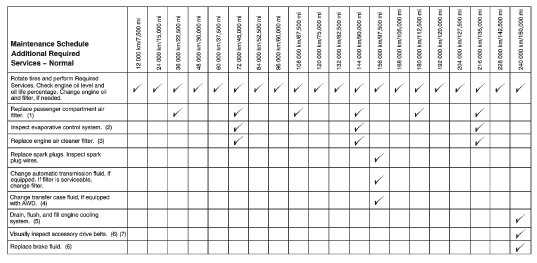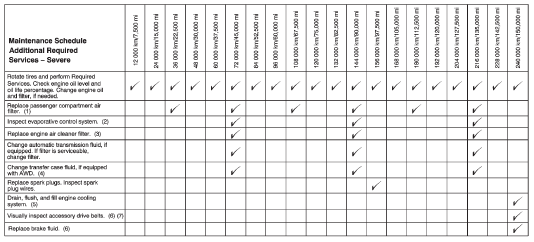
Chevrolet Equinox Owners Manual
Maintenance ScheduleService andMaintenance / Maintenance Schedule
Owner Checks and Services
At Each Fuel Stop
• Check the engine oil level.
Once a Month
• Check the tire inflation pressures.
• Inspect the tires for wear.
• Check the windshield washer fluid level.
Engine Oil Change
When the CHANGE ENGINE OIL SOON message displays, have the engine oil and filter changed within the next 1 000 km/600 mi. If driven under the best conditions, the engine oil life system might not indicate the need for vehicle service for more than a year. The engine oil and filter must be changed at least once a year and the oil life system must be reset. Your trained dealer technician can perform this work.
If the engine oil life system is reset accidentally, service the vehicle within 5 000 km/3,000 mi since the last service. Reset the oil life system when the oil is changed.
Tire Rotation and Required Services Every 12 000 km/ 7,500 mi
Rotate the tires, if recommended for the vehicle, and perform the following services.
• Check engine oil level and oil life percentage. If needed, change engine oil
and filter, and reset oil life system.
• Check engine coolant level.
• Check windshield washer fluid level.
• Visually inspect windshield wiper blades for wear, cracking, or contamination.
• Check tire inflation pressures.
• Inspect tire wear.
• Visually check for fluid leaks.
• Inspect engine air cleaner filter.
• Inspect brake system.
• Visually inspect steering, suspension, and chassis components for damaged, loose,
or missing parts or signs of wear.
• Check restraint system components.
• Visually inspect fuel system for damage or leaks.
• Visually inspect exhaust system and nearby heat shields for loose or damaged parts.
• Lubricate body components.
• Check starter switch.
• Check automatic transmission shift lock control function.
• Check ignition transmission lock.
• Check parking brake and automatic transmission park mechanism.
• Check accelerator pedal for damage, high effort, or binding.
Replace if needed.
• Visually inspect gas strut for signs of wear, cracks, or other damage. Check the
hold open ability of the strut. See your dealer if service is required.
• Inspect sunroof track and seal, if equipped.

Footnotes — Maintenance Schedule Additional Required Services — Normal
(1) Or every two years, whichever comes first. More frequent replacement may be needed if the vehicle is driven in areas with heavy traffic, areas with poor air quality, or areas with high dust levels.
Replacement may also be needed if there is a reduction in air flow, excessive
window fogging, or odors.
(2) Check all fuel and vapor lines and hoses for proper hook-up, routing,
and condition. Check that the purge valve, if the vehicle has one, works properly.
Replace as needed.
(3) Or every four years, whichever comes first.
(4) Do not directly power wash the transfer case output seals. High pressure
water can overcome the seals and contaminate the transfer case fluid. Contaminated
fluid will decrease the life of the transfer case and should be replaced.
(5) Or every five years, whichever comes first.
(6) Or every 10 years, whichever comes first.
(7) Inspect for fraying, excessive cracking, or damage; replace, if needed.

Footnotes — Maintenance Schedule Additional Required Services — Severe
(1) Or every two years, whichever comes first. More frequent replacement may be needed if the vehicle is driven in areas with heavy traffic, areas with poor air quality, or areas with high dust levels.
Replacement may also be needed if there is a reduction in air flow, excessive
window fogging, or odors.
(2) Check all fuel and vapor lines and hoses for proper hook-up, routing,
and condition. Check that the purge valve, if the vehicle has one, works properly.
Replace as needed.
(3) Or every four years, whichever comes first.
(4) Do not directly power wash the transfer case output seals. High pressure
water can overcome the seals and contaminate the transfer case fluid. Contaminated
fluid will decrease the life of the transfer case and should be replaced.
(5) Or every five years, whichever comes first.
(6) Or every 10 years, whichever comes first.
(7) Inspect for fraying, excessive cracking, or damage; replace, if needed.






